
Get your FREE 30-day trial.
Please complete all fields.
One of the most exciting features in the Service Cloud Console is Keyboard Shortcuts (also known as Hotkeys). Keyboard Shortcuts allow users to navigate, edit and save records using just the keyboard. They can be used to launch custom action as well. Once you start collapsing multiple actions into a single keyboard shortcut, it's hard to stop.
Keyboard Shortcuts for the Service Cloud Console come in two flavors, standard and custom. Standard shortcuts are predefined and available in the setup area. They can only be changed or disabled, not deleted. Standard shortcuts include navigation and editing keys.
To use a standard shortcut, focus on the console (also known as entering shortcut mode). This is usually the "esc" key. You'll know when you are in shortcut mode when an orange box highlights the area that will receive your shortcut key.
Once you get a visual confirmation, entering a shortcut key will trigger the corresponding action. Note that if you are already in shortcut mode, you don't need to enter it again. This means that there is no need to hit esc before every shortcut. It's usually only needed when you want to focus away from a text box to subsequently enter a shortcut.
Navigation shortcuts allow you to navigate in the Console. In the example below, we open a record from a pinned list view.
Press the "n" key to select the Navigation Tab Panel
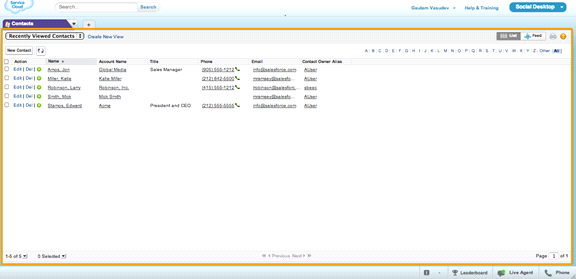
Use the arrow keys to select a record and the "Enter" key to open it. The selected record will be highlighted in blue.
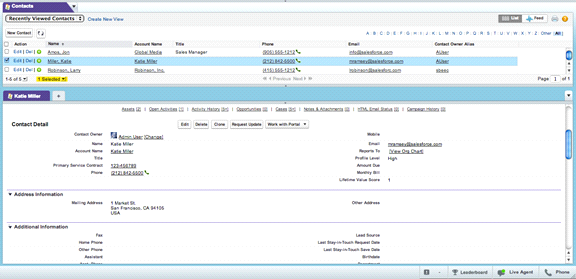
Editing shortcuts allow you to edit or save records in the Console. In the example below, we edit a contact record.
Pressing the "e" key puts the record in Edit mode.
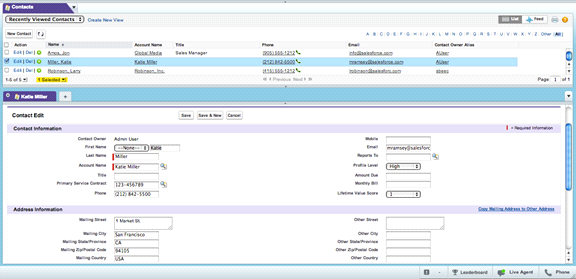
Customers or partners define custom shortcuts. When used, they launch a global Console event. A Console listener can then react to these events using an event receiver defined with the Service Cloud Console Integration Toolkit. The significance of this architecture cannot be understated. This means that a custom keyboard shortcut can invoke Console Toolkit methods, which means that they can perform all the actions supported by the Toolkit, along with Apex and Visualforce callouts. The takeaway here is that a custom shortcut can launch a host of user interface and data operations, which makes for some very powerful shortcuts.
Some examples of custom shortcut configurations are shown below.
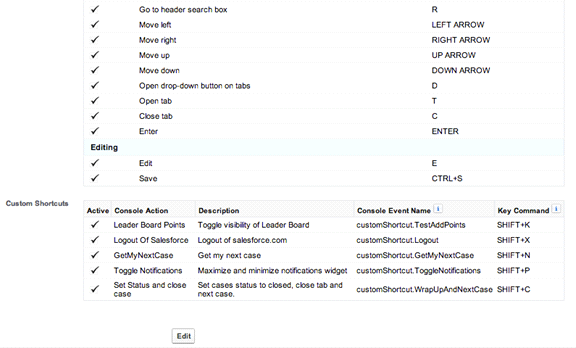
One of the simplest keyboard shortcuts is logging out of Salesforce. Let's set it up.
First, go to the Keyboard Shortcuts setup page for your Console and via Setup-> Create-> Apps-> Your Console -> "Customize keyboard shortcuts"-> Edit.
Now add a new shortcut. "Click Add Keyboard Shortcut"

Fill out the shortcut details. Note that the name of the shortcut event is name spaced with "customShortcut". This is good practice and avoids possible conflicts with existing or future events in the Console.
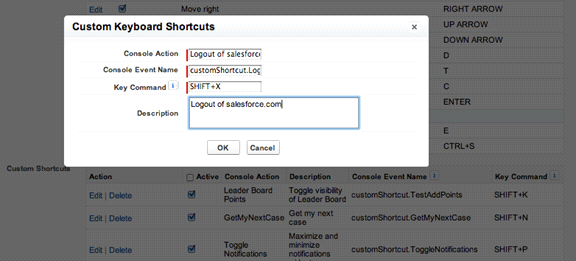
Now we save and move on to the next step.
Since we want the shortcut to be available at all times, the listener must also be available at all times in the Console. Footer components are a good fit for housing such a listener, since they are always on the Console page and cannot be closed.
Additionally, we don't want to display any information to the user when the shortcut is invoked, so we will keep our listener hidden.
To build our listener component, first we create the Visualforce page that contains the listener logic. Let's name the page cccShortcutsListener (ccc stands for Custom Console Component). The code for this can be found here - http://wiki.developerforce.com/page/Efficiency_Gains_With_Keyboard_Shortcuts
Next we create the Console Footer Component to house this listener. This can be done on Setup-> Customize-> Service Cloud Console-> Custom Console Components-> New. Create a new component for cccShortcutsListener and save. Be sure to set the component as "Hidden". Let's name our component "ShortcutsListener".
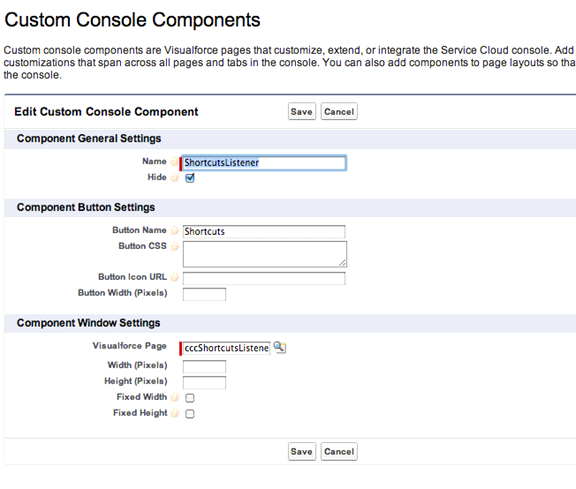
Finally we add the new ShortcutsListener component to our Console. Go to Setup-> Create-> Apps-> Your Console and add it.

That's it. The next time you open the Console and hit Shift+X, you will be logged out of salesforce.com.
Some additional sample shortcuts are listed below, along with the number of clicks saved.
The code for these shortcuts is available here - http://wiki.developerforce.com/page/Efficiency_Gains_With_Keyboard_Shortcuts
Keyboard shortcuts can help eliminate clicks and automate agent flows. Custom keyboard shortcuts offer significant flexibility with the ability to invoke JavaScript, Apex and Visualforce calls. It is important to keep in mind however that hotkeys must be used appropriately, complement mouse action, and always have a clear UI alternative.
If you have any questions or feedback about custom interaction logs, please feel free to reach out to myself or Michael Ramsey. We would love to hear suggestions about other Service Cloud blog topics as well.